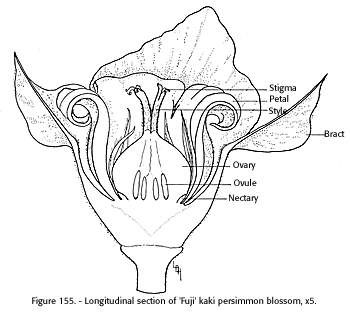PERSIMMON (ORIENTAL OR KAKI)
Diospyros kaki L. f., family EbenaceaeThe Oriental or Kaki persimmon (fig. 153) is cultivated for its delicious, highly nutritious, pale-orange to red, 1- to 5-inch, zero- to eight-seeded fruit that may be eaten out of hand or used in culinary dishes ranging from appetizers to yogurt.
It is grown on about 500 acres in California (Swedberg and Nelson 1970) and to a lesser extent in several other Southern States. It is hardy as far north as Pennsylvania (Griffith and Preston 1961).
The Oriental should not be confused with the smaller-fruited but edible American persimmon (D. virginiana L., and D. texana Scheele) (fig. 154), which are common forest plants but rarely cultivated except as dooryard ornamentals (Pape 1957). The fruits of D. virginiana also contain up to eight large seeds. The trees are generally dioecious, with single pistillate flowers and usually three staminate flowers in a group. The pollen is generally carried from the staminate to the pistillate flowers by insects, but Fletcher (1942) stated that wind may also contribute. The flowers are a good source of nectar and are visited throughout the day by bees for nectar and pollen (Pellett 1947*). Oertel (1939) listed D. virginiana as a major source of nectar in five States and of some value in 22 States, indicating that in acres it is far more common than the Oriental one. (See also Condit 1919, and Preston and Griffith 1966.)
[gfx]FIGURE 153. - Complete and sectioned fruit of kaki persimmon.
FIGURE 154. - Fruiting branch of American persimmon.

Plant:
The Oriental persimmon is a round-topped, usually deciduous, tree to 20 feet high unless it is competing with other trees for light, when it might reach 40 feet. It has 3 to 7-inch elliptic glossy leaves and 3/4 inch long, yellowish-white flowers. The fruit is variable in shapeÑ oval, round, globular, or elongatedÑand ribbed with brownish pulp surrounding the seed, if any are present. Cultivation is similar to that of citrus or stone- fruit trees grown in warmer areas. Camp and Mowry (1945) reported 14 to 18 percent total sugars in the mature fruit.
Inflorescence:
The campanulate flowers are three-quarters of an inch long and yellowish white, with outfolded, prominent green sepals extending beyond the corolla. The staminate ones have 16 to 24 stamens, the pistillate ones have eight staminodia (Bailey 1949*) (fig. 155). Nectar secretion is probably similar to that of the American species. The blossoms hang downward, with the stigma rarely exposed beyond the petals, which offers little opportunity for wind pollination. Hume (1913) stated that no crosses between D. kaki and D. virginiana had ever resulted in production of viable seed.
[gfx] FIGURE 155. - Longitudinal section of 'Fuji' kaki persimmon blossom, x 5.
Pollination Requirements:
Ryerson (1927) stated that Oriental persimmon trees may be staminate, pistillate, or both, but that pollination is not essential for fruit setting. He believed that ample crops of seedless fruits could be obtained without pollination. Hodgson (1938) confirmed that Oriental plants produce seedy fruits if pollinated but set a few of the preferred seedless fruit if no pollen is available. Later, Hodgson (1939) stated that there was a high degree of parthenocarpy, and that various cultivars of Orientals contained the following types of plants: (1) Pistillate; (2) pistillate, sporadically monoecious; (3) monoecious; (4) monoecious, sporadically staminate or pistillate; and (5) staminate.
Gould (1940) concluded there are pollination problems with Oriental persimmons just as there are with many other fruits. Some cultivars will develop some fruit to maturity without pollination, whereas other cultivars drop their fruit prematurely or fail entirely to set without pollination. The length of time to flower opening and the actual time of pollination of individual flowers has not been determined.
Pollinators:
Honey bees and bumble bees visit persimmon blossoms freely for nectar and pollen and would appear to be dependable agents in the transfer of pollen. Fletcher (1942) stated that pollen is generally distributed by bees although wind can carry the pollen great distances. The effectiveness of wind on the downward hanging campanulate flower would appear to be minor. Abbott (1926) stated that pollen from our native species does not cause Oriental persimmon fruit set, but the pollen must come from staminate Oriental plants.
Pollination Recommendations and Practices:
None.
LITERATURE CITED:
ABBOTT, C. E.
1926. THE KAKI AND THE LOQUAT. Fla. State Hort. Soc. Proc. 39: 228-233.CAMP A. F. and MOWRY. H.
1945. THE CULTIVATED PERSIMMON IN FLORIDA. Fla. Agr. Expt. Sta. Bul. 124, 31 pp.CONDIT, I. J.
1919. THE KAKI OR ORIENTAL PERSIMMON. Calif. Agr. Expt. Sta. Bul. 316, pp. 231-266.FLETCHER, W. F.
1942 THE NATIVE PERSIMMON. U.S. Dept. Agr. Farmers' Bul. 685, 22 pp.GOULD, H. P.
1940. ORIENTAL PERSIMMONS. U.S.. Dept. Agr. Leaflet 194, 8 pp.GRIFFITH, E., and PRESTON, W. H., JR.
1961. THE ORIENTAL PERSIMMON IN MARYLAND, VIRGINIA AND PENNSYLVANIA. Plants and Gard. 17(1): 32-34.HODGSON, R. W.
1938. GIRDLING TO REDUCE FRUIT DROP IN THE HACHIYA PERSIMMON. Amer. Soc. Hort. Sci. Proc. 36: 405-409.______ 1939. FLORAL SITUATION, SEX CONDITION AND PARTHENOCARPY IN THE ORIENTAL PERSIMMON. Amer. Soc. Hort. Sci. Proc. 37: 250252.
HUME, H. H.
1913. THE FLOWERING OF DIOSPYROUS KAKI. St. Louis Acad. Sci. Trans. 12(5): 125-135.OERTEL, E.
1939. HONEY AND POLLEN PLANTS OF THE UNITED STATES. U.S. Dept. Agr. Cir. 554, 64 pp.PAPE, E. W.
1957. THE AMERICAN PERSIMMON. Organic Gard. and Farming 4(11): 28.PRESTON, W. H., JR., and GRIFFITH, E.
1966. CURRENT STATUS OF THE ORIENTAL PERSIMMON IN TEMPERATE EASTERN UNITED STATES. North. Nut Growers' Assoc. 57th Ann. Rpt.. pp. 112-123.RYERSON, K. A.
1927. CULTURE OF THE ORIENTAL PERSIMMON IN CALIFORNIA. Calif. Agr. Expt. Sta. Bul. 416, 63 pp.SWEDBERG, J. H., and NELSON, G. A.
1970. CALIFORNIA FRUIT AND NUT ACREAGE. Calif. Crop and Livestock Rptg. Serv., 19 pp.
